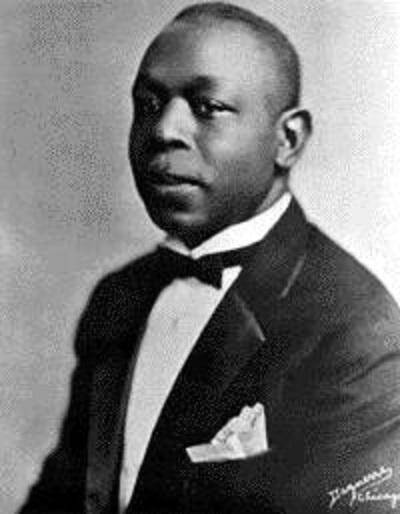
Much has been written about Johnny Dodds. Unfortunately the biography by Lambert (1961) that inspires much of it is not well-researched and is mostly a personal appreciation of some of his recordings.
The discography by Dürr (2000), is not only a discography of all known 78 RPM records, but has an excellent bibliography and the last pages have important biographical information, reprints of letters and an interview with Johnny Dodds’ eldest son. Example: Johnny Dodds’ “sex education” of his two son’s was putting a revolver to his eldest son’s temple and saying “If you ever ruin the life of another man’s daughter – I don’t care how ugly she is, how short her hair or how skinny her legs – I’ll blow your brains out”.
The Solo Style Of Johnny Dodds by the late Patricia A, Martin (2003) is an essential publication which is well-researched and has an excellent bibliography. She avoids making value judgements. There are, unfortunately, rather a lot of mistakes – wrong dates, wrong personnel and many other trivia.
Johnny Dodds was born on 12 April 1892 in uptown New Orleans. His father was a warehouse employee. He had two elder sisters and one elder brother, his younger brother Warren ‘Baby’ Dodds was born on 12 December 1894; he became a skillful drummer. In about 1901, the family moved to a farm in Waveland, Mississippi. The two sons went to school in Bay St Louis a few miles east of Waveland. In May 1904, Dodds’ mother died. The family lived with the father who gave Johnny his first clarinet in 1908 – he previously played tin whistle. He was taught the rudiments of the instrument in Bay St Louis. In 1940, he told Bill Russell that after five lessons he knew more than his teacher.
According to Joe Robichaux (piano player, band leader and nephew of Johnny Dodds), in ca. 1914, he together with Johnny Dodds took music lessons with Dave Perkins (cited by Vernhettes & Lindström. 2019). Presumably to improve his reading.
Dave Perkins (ca. 1872 to 1926), quoting Jack ‘Papa’ Laine, was a Mulatto and acquired a first-class musical education and later, taught music of all origins from about the 1890s. He played with white and colored bands. According to his cousin Pops Forster, he became president of the White Musicians Union in New Orleans.
Apart from Johnny Dodds and Jack Laine he also taught the trombonist Morris French and, according to Stella, Joe ‘King’ Oliver’s wife, he also taught Joe Oliver. Aside from teaching, he played in numerous bands. In 1918, he played trombone in Manuel Perez’s Creole Jazz Band and in the early 1920s his own band played on the Streckfus Steamer Capitol. Dave Perkins married a white woman. Laine was racist and did not approve of ‘n***** bands’. Although Laine knew Perkins was a Mulatto, he never disavowed him.
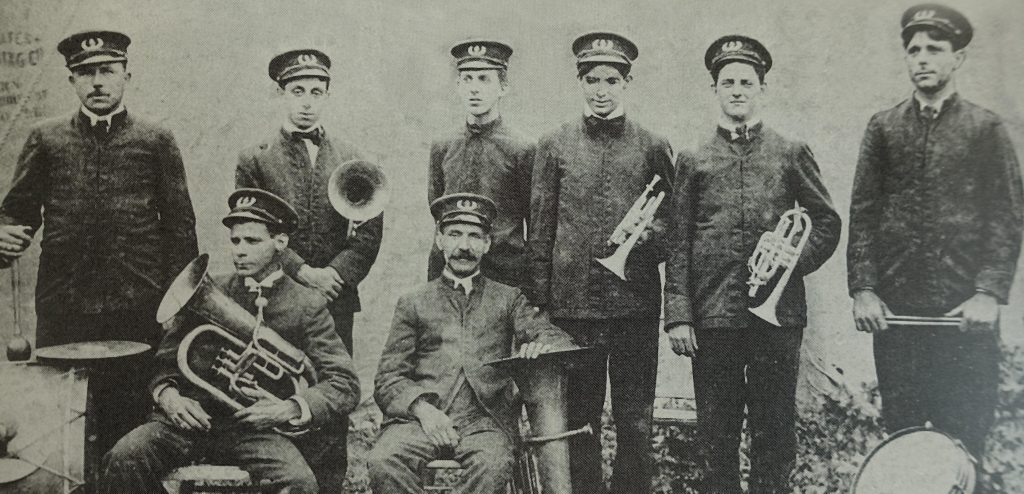
Later, about 1919, Johnny Dodds studied under Charles McCurdy in New Orleans. Also, according to Russell, Dodds listened to Big Eye Louis Nelson, Alphonse Picou, George Bacquet, and Lorenzo Tio Jr. In 1940, he told Charles E. Smith that Sidney Bechet was the first person to influence him. From Bechet, he adopted the double embouchure (both lips between teeth and mouthpiece), which, incidentally, Benny Goodman adopted after lessons from Reginald Kell, the famous British concert clarinetist who moved to the USA.
In 1909, Johnny Dodds moved to New Orleans and got a job at the Empire Rice Mills. Apparently, he practiced during the lunch break and in 1911/12 was discovered by Pops Forster. By 1912, he was a full-time musician in Kid Ory’s Creole Ragtime Band in New Orleans. From then onwards, he was a professional musician until his death. Stories about him driving a taxi are unfounded.
A short biography of Charles McCurdy has been published in Vernhettes & Lindstöm p.19, 20 (2012). He was a New Orleans native, born in 1872 and died about 1937. He joined John Robichaux’s Orchestra at the turn of the century after being trained by Professor Lorenzo Tio Sr. According to Peter Bocage, interviewed in 1959, “Charlie McCurdy was a crack musician who played three clarinets (Bb, C, A) in the Robichaux band and played the C clarinet in parades with the Excelsior Brass Band”. I guess by “C” clarinet, “Eb” clarinet is meant.
About 1904, he was photographed in John Robichaux’s Orchestra, he is holding a Bb rather ancient, Albert or Simple System (Müller type) instrument with 13 keys, two rings, two trill keys and no rollers and in his lap, are similar instruments in A and Eb. This kind of instrument, an Albert clarinet from 1877 is shown on the photo Fig. 4. Albert and other makers were making more complex, thus easier to play, instruments in 1858.
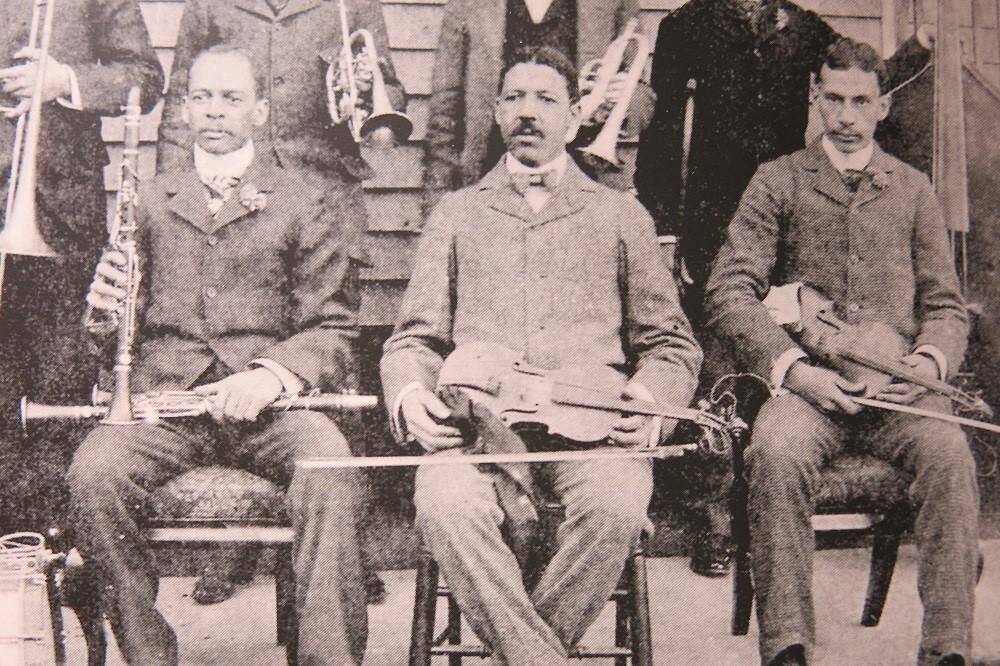
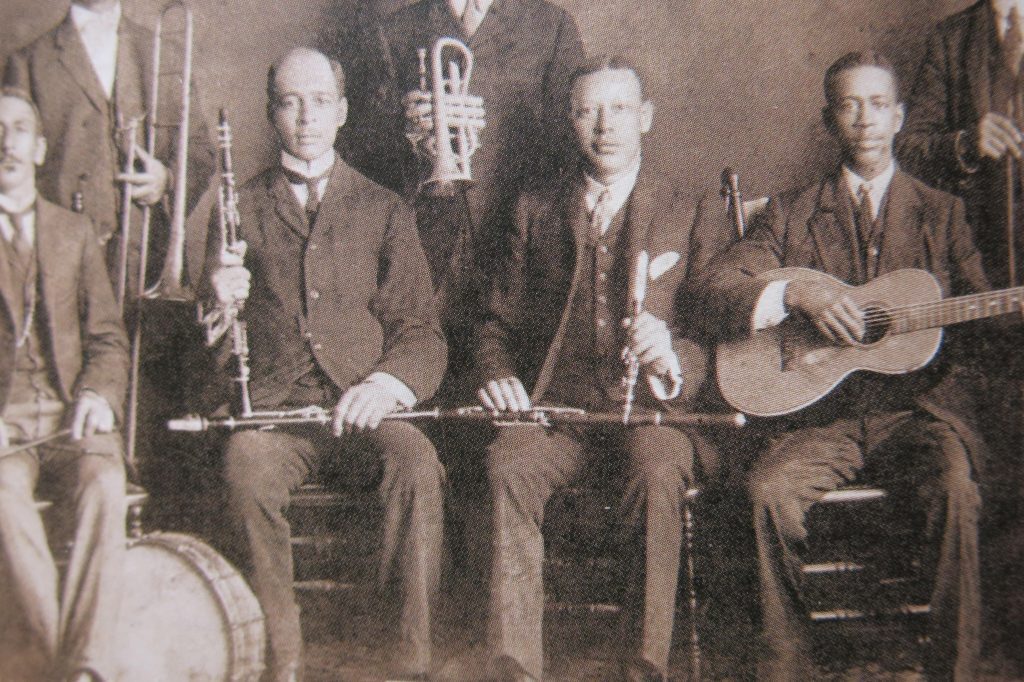 Barney Bigard told Barry Martyn: “Charlie McCurdy was quite a musician, but he wasn’t a jazz player, because he couldn’t improvise at all”. Big Eye Delisle told Robert Goffin that McCurdy played with Buddy Bolden in Henry Peyton’s band in 1900 – this seems rather strange. Ed Garland said he was the first in New Orleans to play all clarinet parts on his Bb clarinet, including those in A – this is most unlikely, particularly as Albert instruments do not reach down to Eb, or had he gotten a Full Oehler instrument or maybe converted to Full Boehm instrument?
Barney Bigard told Barry Martyn: “Charlie McCurdy was quite a musician, but he wasn’t a jazz player, because he couldn’t improvise at all”. Big Eye Delisle told Robert Goffin that McCurdy played with Buddy Bolden in Henry Peyton’s band in 1900 – this seems rather strange. Ed Garland said he was the first in New Orleans to play all clarinet parts on his Bb clarinet, including those in A – this is most unlikely, particularly as Albert instruments do not reach down to Eb, or had he gotten a Full Oehler instrument or maybe converted to Full Boehm instrument?
THE JAZZERS’ CLARINET: A VERY MUCH SHORTEND HISTORY AND SOME SEMANTIC PROBLEMS
In 1840, Eugène Albert from Brussels patented a clarinet which became known as the Albert System clarinet.
In 1844, Hyacinthe Klosé and Auguste Buffet patented a different clarinet fingering system called ‘clarinette à anneaux mobiles’ which later became known as the Boehm clarinet. Compared to the original Albert, the Boehm system positions holes and keys for comfort, and eliminated cross-fingerings, while at the same time making the instrument more stable and more in tune. The system is like that of the saxophone and flute (the Boehm oboe and bassoon never caught on). The plain Boehm has 24 tone-holes, governed by 17 keys and 6 rings. It was a remarkable development because since 1840 it has hardly changed. Today it is by far the most popular kind of clarinet.
The original Albert clarinet had 21 tone holes 13 of which have pads, 13 keys or levers, 2 rings, both on the lower joint. The A and G# throat keys are not crossed and it had no rollers. This instrument became very popular particularly in military and other marching bands (in Britain it is usually called the Simple System). I have seen this kind of clarinet and heard it being played in the Balkans and in India where it is still being made. My very first clarinet, inherited from an aunt, was an original Albert in A.
In Europe and perhaps elsewhere, many of these clarinets were made for marching bands which used the old high pitch A4 = 452.5 Hz, or sometimes even higher; some military bands used A4 = 457 Hz. Many ‘jazz purists’ believing they have bought a treasure become disappointed because they cannot be played in the present concert pitch which is A4 = 440 Hz. Unlike some string instruments and some wines, clarinets do not improve with age.

By the 1920s, this original Albert clarinet was not the instrument played by the New Orleans and other early jazz clarinettists. For more serious work, two extra keys were added to the original Albert: a short side key for Eb and a long trill-key A-Bb, also the G# key is crossed over the A key (all copied from the Boehm system) and rollers were mounted on the G# and F keys (this helps the right little finger) and the E and F# keys for the left little finger.
The intonation and tone of the improved Albert instrument is very fine – it has, many people think, never been surpassed. This instrument is, however, difficult to play because the fingers (particularly the right hand) are widely spaced and there are few keys which means few alternative fingerings for most notes. The development of the Albert continued, and more and more rings were added – this brings the fingers closer together but meaning more holes. More keys were added to give alternative fingering which also means more holes. More holes mean great care is needed to keep the instrument in tune. The climax of this development is the Oehler (sometimes spelled Öhler) system
Many musicians who play the Oehler System are convinced that the tone and pitch are better than on a Boehm instrument but because of the greater amount of mechanism required, the technique is more complicated. The standard Oehler clarinet has 22 keys, four more, it may be noted than the Boehm (the full Oehler has 27 keys) and 6 rings, 4 rollers and up to 15 adjusting screws – it is not a simple clarinet and it is not cheap. Also, it is usually rather heavy.
Simpler models were made with 16 to 20 keys and four, five or six rings. These clarinets are and have been marketed under different names: German (Deutches) System is the most common today, Simple System in Britain and ‘Improved Albert’ in USA. This kind of instrument was used by most early jazzers.
JOHNNY DODDS’ CLARINETS
Several earlier authors have stated that Johnny Dodds could not read music. This is untrue. He could read and according to his brother he spent a fortune on sheet music and occasionally even transposed violin parts for the clarinet.
Dodds used the double embouchure (upper and lower lips over the mouthpiece) and a hard to very hard reed. This enabled him to play very loud and develop a very rich tone in the chalumeau and clarion ranges. The disadvantage is that most notes must be tongued (played staccato) which prevents the use of legato. Sidney Bechet, who Dodds considered to have influenced his playing, also had the same restriction.
Many great clarinettists from New Orleans, such as Jimmy Noone, Barney Bigard, Omer Simeon, Albert Nicholas, were taught by Lorenzo Tio Junior who insisted on soft reeds which allowed these players to develop great legato styles (staccato presents no difficulties) and to play in the altissimo range. None of them, however, had the power and volume of Bechet or Dodds.
Dodds was not a great clarinet technician. Mostly, he played in chalumeau (low register) or clarion (claret, clarinet, upper register). He tended to avoid the throat register (from G’ to Bb’ – the range in between chalumeau and clarion – “the dreaded break”). He also rarely used the high altissimo range (above Bb’’) and when he did he probably used his thumb and trill keys with excellent lip control to be in tune rather than using the normal rather complex fork-fingering. His magnificent tone and lip vibrato in both chalumeau and clarion range is difficult to copy.
Patricia Martin (2003) on page 36 writes: “Dodds was known to use a very basic thirteen-key, Selmer model Albert system for most of his career”. This is not substantiated by photographic evidence.
Some very good photographs were taken of King Oliver’s Creole Band in 1922. They clearly show that Dodds had a matched pair of clarinets; presumably an A and a Bb. They were top models. Both of his instruments have 6 rings, 15 keys, 4 rollers and a G# key for the little finger of the left hand. The A clarinet (standing by the piano) shows the cap for the C#4/G#5 key opening on the upper side of the lower joint just above the ring for first finger right hand, see Fig.6.
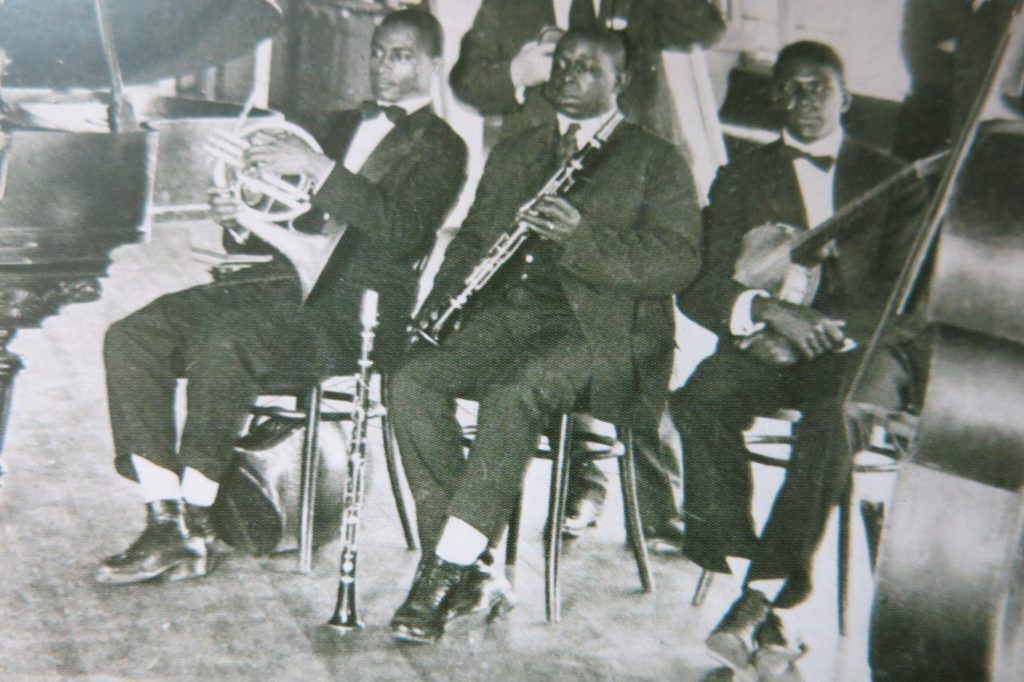
Eberhart Kraut (ca. 2002) wrote an article “Henri Selmer Klarinetten der 1920/30er Jahre” which makes it almost certain that in 1921, Dodds was playing an early Selmer “improved” Albert system instrument with the cup of the E valve on the left-hand side and the key for C#4/G#5 articulated and opening on the upper side of the lower joint just above the ring for first finger right hand. At this time, this instrument was also played by Omer Simeon and Irving Fazola. This model was also used as a template for the huge picture on the façade of the Holiday hotel in New Orleans.

The American makers Penzel & Müller and Meinl were also making instruments like this, Jimmy Dorsey, even in later years, played a simple Albert system instrument. Eddie Miller played a similar instrument which he bought from Jimmy Dorsey; after the Bob Crosby days, Miller changed to the Boehm system.
In pictures from 1926 or 1927 with the Hot Five (Armstrong holds a trumpet), Johnny Dodds seems to be playing the same instrument pictured in 1922 he also has an alto saxophone pictured lying on the piano in one picture and on the floor in another. The Selmer trademark is not visible on any photos of Dodds’ clarinets.
In 1939, Dodds was given a clarinet by Hoyte Kline. In his ‘thank you’ letter Dodds says “It is half Albert and half Boehm”. The upper joint of the Boehm looks rather like the Improved Albert/German System. The photo of this instrument by Ed Lawless, courtesy of John Dodds Jr., is rather poor (see Klatzko 1997, Dürr 2000) but it is certainly a Boehm. It is not the instrument Dodds was pictured playing in 1940.
In 1940, he is photographed in profile from both sides playing an instrument which was probably the top model Selmer because the cup of the E key is on the right side – three cups in line on the right side, see Fig.7. This is the model preferred by many New Orleans clarinetists such as Jimmy Noone, Barney Bigard, Irving Fazola and many others.

The Uebel ‘636’ series also had three cups in a row on the right-hand side, but it was apparently not a great success and not many were produced. I do not know if this model was ever sold in the USA.
The clarinet in A is rarely seen in jazz and dance bands but is essential for ‘classical’ clarinetists. Dodds probably used this instrument to play in the key of G and perhaps sometimes also for Ab and C; other keys suitable for the A clarinet such as A and D are rarely used in jazz. Edmond Hall, also an Albert System player, used an A clarinet on occasion. In the early 1920s, Arnett Nelson is pictured with both A and Bb instruments.
The kind of clarinet that Dodds used in the 1920s is still being made today but is usually marketed as a German (Deutsches) System. It is unclear why the name Albert has disappeared from the catalogs, and why these clarinets are apparently not sold in the USA. They are being made by the following instrument makers (this list is probably incomplete and perhaps partly out of date):
Oscar Adler: now taken over by Gebrüder Mönnig but German system clarinets are sold under the label Oskar Adler. They are made in Markneukirchen, Germany.
Amati – Denaki: made in Kraslice, Czech Republic.
Edelholz & M & N clarinets: made in Stadt Haag, Austria.
Hammerschmidt: made in Burgau, Germany – played by Edmond Hall and Evan Christopher (before Selmer).
Harald Hueyng: hand made to order in Düsseldorf, Germany.
Jupiter: made in Taiwan under German management.
Leitner & Kraus: hand made to order in Neustadt an der Aisch, Germany.
Clemens Meinel, now Rolf Meinel: hand made to order in Wernitzgrün, Germany.
W. O. Nuernberger (Nürnberger): hand made to order in Markneukirchen, Germany. This firm has nothing to with clarinets labelled: “William Nuernberger, American Artist” – they were made by Gebrüder Mönnig, Markneukirchen.
Herbert Neureiter: hand made in Söll, Austria.
Prof. Romero Orsi, Tradate, Italy: hand made to order; they will even make plateau models or metal clarinets – perhaps the last maker of metal clarinets.
Schreiber & Keilworth: they have recently been bought by Buffet – German system clarinets sold under the name Schreiber.
Schwenk & Seggelke: hand made to order in Bamberg, Germany – played by Dr Michael White.
F. Arthur Uebel made or ‘finished’ in Marktneukirchen, Germany – played by me (after 1963, Uebel instruments were mass produced and just ‘finished’ in Germany – secondhand buyers should choose numbers below 17,800). Their instruments of today are acceptable.
Wurlitzer: made to order in Germany. On their American website, Wurlitzer only offers its special reform Boehm clarinets.
Yamaha: made in Japan?
There are some cheap brands that might or might not be playable, most are of Chinese origin: Roy Benson, Eastman, Emerson, Karl Glaser, HSR, Mc Brown, Miwazaki, Palatino, Steinbach, Swing, Thomann, Tim Hendson, T. Tsunami, Tuyama and probably some others – do not buy any of these before trying them out. Today, some of the Buffet Group and Conn-Selmer instruments are also made in China.
Martin (2003), on page 34 writes: “Photographs of jazz bands and other musical groups show no evidence of a Boehm-system clarinet until about 1928”. This is not the case. In 1914 Arnett Nelson was playing a Boehm and received a Full-Boehm instrument from C. G. Conn.
The earliest photographs of Boehm clarinets in jazz bands that I have found are: Rudy Wiedoeft appears to have one in 1917 with the Frisco Jazz Band. In 1921, Don Redman with Fletcher Henderson; Don Pasquall with Vassar’s Scale Steppers. In 1922/3, Arnett Nelson with Jimmy Wade, still using a Full-Boehm model, Volly De Faut with the Sig Meyer Band. In 1923, Buster Bailey with Fletcher Henderson, Bill E. Schmidt with The Peacock Orchestra, Joe E. Poston & Robert Shelby with Cook and his Dreamland Orchestra, Irving Fazola in Louis Prima’s Kid’s Band. In 1924, Buster Bailey with Joe ‘King’ Oliver and with Fletcher Henderson. 1925 Eddie Cherie with Manuel Perez, Willie Lewis with Sam Wooding’s Club Alabam Orchestra, Don Murray and Fud Livingston. 1926 Volly De Faut (also pictured with a Full-Boehm model) and Danny Polo. There are photographs of other unnamed pre-1928 clarinetists in the bands of Erskine Tate and Willie Hightower.
Irving Fazola, in later years played a Selmer Improved Albert clarinet (Fig. 7), but in ca. 1923 he is pictured at the age of 13 in Louis Prima’s Kids’ Band (Driggs & Lewine, 1982). On the floor in front of the musicians are four saxophones (2 sopranos, 1 alto and 1 tenor) and a solitary Boehm clarinet. In 1930 with the Prima-Sharkey Orchestra, he is pictured holding an alto saxophone and possibly a Boehm clarinet at his feet (the photograph is not very clear); Nino Piconi with tenor and an unnamed alto player also have Boehm clarinets at their feet. Luke Schiro, cited by Chilton (1983) states that for a brief period Fazola started to learn Boehm system with Jean Paquay in New Orleans but then studied Albert system with Professor Guiffe. I suspect that Schiro got his dates wrong because he states that Fazola began playing “around 1928”.
IMPROVED ALBERT/OEHLER/GERMAN/SIMPLE OR BOEHM: WHICH IS BEST?
Today, musicians who play the Abert/Oehler system often spend time praising its tone and saying how good it is; Boehm players cannot see what the fuss is all about. Compared to the Albert/German/Oehler, the Boehm has lots of positive features:
1. it is easier to play – it was designed for human fingers and it eliminates cross-fingerings.
2. it is standardized – nearly all Boehm instruments are much alike.
3. it is easy to manufacture and can be made cheaply – one can buy expensive ones.
4. it is relatively robust
Disadvantages of the Improved Albert/Oehler/German/Simple
1. it is difficult to play – the fingers are far apart, particularly the right hand, and either there are not enough or too many alternative fingerings.
2. it is not standardized – today it is made in versions with 18 to 27 keys with 2, 4, 5 or 6 rings.
3. it is difficult to manufacture and is expensive. (beware of newly made cheap ones)
4. it is fragile – it has some long levers and several adjusting screws.
The only professional New Orleans jazz clarinetist I have found who has converted from Boehm to Albert/Oehler/German/Simple system is Irving Fazola but there are several who have converted from Albert to Boehm:
Albert Nicholas switched because of the instrument’s fragility – his Improved Albert Selmer broke down in Egypt and had to be sent to France for repair. By the time he got it back he had adapted himself to the Boehm and stayed with it.
Eddie Miller – in his own words: “I had to change to Boehm (pronounced Bay-em in New Orleans) system, because even the third clarinet parts contained fingering that was just too fast for my old clarinet” Before he converted he played an Albert clarinet that he got from Jimmy Dorsey in the mid-1920s.
Other New Orleans clarinetists who changed from Albert to Boehm are Joe Darensbourg and Tony Parenti.
The claim that the tone is better than the Boehm will not withstand blindfold tests. Classically trained clarinetists try to sound alike while jazz clarinetists like to sound individually different. One may identify the player but not the instrument that is being played. In blindfold test of classic (for want of a better name)clarinetists, the jury was not able to distinguish Boehm players from German system ones except for one musician; they were all convinced that Sharon Kam played German system – she, in fact plays a Boehm!
It is the player’s mouth (embouchure) is responsible for the tone. This was brought home to me at a party; I heard Albert Nicholas play Sandy Brown’s clarinet. When Nicholas played it sounded like Nicholas when Brown played it sounded like Brown (rather close to Dodds and miles away from Nicholas, incidentally Brown played without his teeth using a wooden mouthpiece, but this did not faze Nicholas).
George Lewis certainly played many different kinds of ‘Albert’ clarinet from simple to complex – by just listening it is not possible to distinguish them; for a while he played an instrument that belonged to Jimmy Noone – this did not make him sound like Noone. Woody Allen demonstrates that not all Albert clarinets produce a good tone. Theoretically, the Albert/German/Oehler clarinet should have a special kind of mouthpiece unlike the French or Boehm kind. Pete Fountain (Boehm) inherited Irving Fazola’s (Improved Albert) mouthpiece; Fountain found it wonderful, but can any outsider tell the difference?
HAS THE ALBERT/GERMAN/OEHLER A FUTURE?
In Germany, Austria and some other eastern European countries most classically trained clarinetists play the Oehler system in spite of its disadvantages. I believe the reason is simple. The older and most respected teachers play the Oehler because their teachers used this system and students of today get jobs through recommendation from their teacher – quite simple really.
Musicians who today play in the manner of jazz clarinetists from the 1920s or 1930s, appreciate later clarinet players from New Orleans and like to follow in the footsteps of their mentors. There are today skilled jazz musicians playing Albert system instruments, for instance, Evan Christopher and Mattheus Seuffert (both Selmer Improved Albert (L-series or occasionally K-series), Dr Michael White and Wolfgang ‘Muffel’ Weth (both Full Oehler).
BIBLIOGRAPHY
Briggs, Frank & Lewine, Harris. Black Beauty, White Heat. William Morrow & Co. Inc., New York 1-360 (1982).
Chilton, John. Stomp Off Let’s Go. Jazz Book Service, London 1-248 (1983)
Dürr, Klaus-Uwe. The Recordings of Johnny Dodds. Privately published by Klaus-Uwe Dürr, Hamburg 1-39 (2000).
Klatzko, Bernhard. The most complete biography of Johnny Dodds, 78 Quarterly No. 1 (Vol. 1, No. 10): 77-101 undated (written 1997, publ. ca 1999).
Kraut, Eberhart. Henri Selmer Klarinetten der 1920/30er Jahre. Sonic – Magazin für Holz- und Blechinstrumente, PNP-Verlag, 92318, Neumarkt, Germany Vol: 3: 10 unnumbered pages, undated (ca. 2003).
Lambert, G. E. Johnny Dodds. (Kings of Jazz Series). Cassell & Co. Ltd., London 1-90 (19619.
Martin, Patricia A. The Solo Style of Jazz Clarinetist Johnny Dodds: 1923-1938. i-vii, 1-142 (2003). A Monograph submitted to the Graduate Faculty of the Louisiana State University and Agricultural and Mechanical College in partial fulfillment for the degree of Doctor of Musical Arts. Available as PDF: http://etd.lsu.edu/docs/available/etd-0118103-203326/unrestricted/Martin_dis.pdf This is an essential publication which is well researched and has a very good bibliography. She avoids making value judgements. There are, unfortunately, rather a lot of mistakes – wrong dates, wrong personnel and many other trivia.
Vernhettes, Dan & Lindstöm, Bo. Jazz Puzzles Volume 1. Jazz‘ Edit. (www.JazzEdit.org) 1-140 (2012).
Vernhettes, Dan & Lindstöm, Bo. Jazz Puzzles Volume 3. Jazz‘ Edit. (www.JazzEdit.org) 1-212 (2019).
Christopher D. K. Cook played clarinet with several revivalist groups during the 1960s in Edinburgh, Derby, Cambridge, Munich (Germany) and finally Liverpool. He lives in Switzerland where he spent his professional career as a noted botanist and researcher.






















